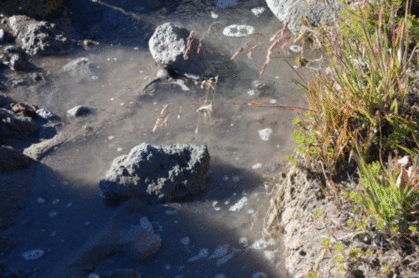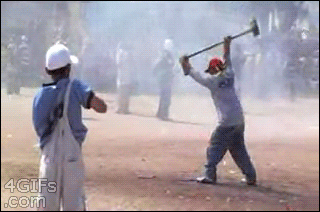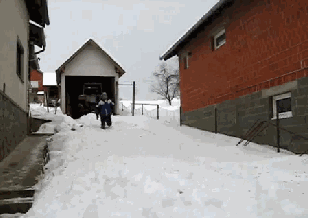Jessica Ball, AKA Tuff Cookie, AKA the author of Magma Cum Laude, earlier asked a question to which I can relate: namely, how does one approach teaching a (potentially) controversial subject?
First, you want to make sure you know your stuff. Students can smell instructor uncertainty. Definately familiarize yourself as well ahead of time as you can with the textual material your students will be using. I've seen a decent student in science ed get chewed up and spat out because he was really not qualified to TA the subject matter- he didn't have to take that position, he had other options, but thought it would be "fun." I was teaching a different section of the same course, and in some ways was a bit better prepared- though not academically. The difference was I had an interest in the material, I had done plenty of reading about it on my own, and I made sure I understood it better than the students were going to be expected to. I can honestly say the same would be true on the topic of climate change- I've had little formal classwork on the subject, but it's very interesting to me, and I've done a lot of independent reading on it. Below is a list of climate and related blogs/sites I follow in RSS, and a brief sketch of the value I get from each.
Arctic Sea Ice News & Analysis- This may seem like a very esoteric topic, but Arctic sea ice appears to be the most sensitive component of out planet with respect to climate change. It can be viewed as the "canary in the coal mine" or "bellwether" for the rest of the planet. And this is the go-to site for data tracking daily to long term trends in the ice pack up top. Their monthly, seasonal, and annual summaries are don't miss. And their coverage of the approach to least extent in mid-September is stunningly good and gripping.
Arctic Sea Ice Blog- This guy makes no pretense of being an "expert" (do take a moment to read the disclaimer) but he's clearly no slouch, and clearly finds the topic fascinating. He's also very good at finding important statistics and data.
Real Climate- Gotta be honest, this one is generally a bit too wonky for me. I generally skim the posts enough to get the general gist, then skip the gory details. Still, it's a good one for keeping abreast of current news.
Open Mind- One of my favorites of the bunch. There are times when the detailed approach to stats is more than I want to wade through, but generally readable. In particular, Tamino goes out of his way to bluntly take down nonsense from deniers, with Anthony Watts front and center (See "Dishonorable Mention," below).
Jeff Master's Wunderblog- Not a "climate blog" per se, but weather-focused. I think Masters would be among the first to point out meteorology and climate science are different (if related) disciplines. However, news related to climatology pops up there regularly- such as today's post on billion-plus dollar disasters and top ten meteorological events of 2012.
Dishonorable Mention: Watts Up With That? Not recommended as regular reading, but you should know what the deniers are up to... and Anthony Watts is probably the highest-profile denier out there. I often find his posts through links from take-downs, and there is a certain pleasure in reading one and spotting the fallacy (or fallacies) on one's own. The errors take on a few standard forms: misrepresentation or faulty selection of data, misunderstanding or faulty implementation of statistical methods, conflating adjustments to data (which have been debated, discussed, and finally accepted among a large community of qualified scientists as providing better accuracy) as "fudging" or "making up" data and so on. And when all else fails, fall back on ad hominem attack, which in some circles is apparently a valid debating tactic.
Continuing, it also helps to have enough confidence to flatly state "I don't know,"
when that's accurate. And if the question is important enough to merit
it, follow though and find out- then share the answer with the class and/or questioner as seems appropriate. On the other hand, do not
promise to follow through on every question. Many are trivial (there's
no harm in curiosity, but it can waste a lot of time), and in many, many
cases, it's as easy for the student to Google the answer as it is for
you. (I love LMGTFY, but it's a bit too snarky to use on any but the most pesky student.)
Don't proselytize. Your job is to inform, not convert. My attitude with respect to evolution was "I don't much care if you 'believe in' evolution or not, but I expect you to understand why most scientists do." For example, I *understand* the tenets of Christianity pretty well- enough to discuss them intelligently- and I think that's important due to the profound cultural impacts of that belief system. That doesn't mean I believe it. Likewise, I understand the ideas, and wonderful twists of logic in "Alice in Wonderland." We each have the freedom to choose what we do and don't believe, but in an academic setting, choosing not to know the consensus in terms of facts has a price- several prices, actually. Grades, advancement, and future performance are all at stake. Letting students know you're looking for understanding, not agreement, can defuse an urge to "push back" against a perceived "agenda." Along similar lines, accept dissent calmly, but ask for reasoned supporting evidence. [Followup: was just outside for a smoke, discussing this with another IZ patron. His comment: "It's like a comparative religion class. The goal is obviously not to convert anyone to any particular religious belief system, but to get everyone to a certain level of understanding."]
I just went back to figure out exactly what the position was; don't be afraid to ask your team-teaching prof- who presumably has much more expertise and experience- for advice, especially when/if sticky situations come up.
Since many topics of this type can be bleak and depressing, find and keep success stories in reserve. How does this relate to controversy? When faced with what seems like inevitable doom, humans are tempted toward two options: fatalistic acceptance, or denial. Both lead to doing nothing. Remind students often that we actually do have quite a number of options for coping with climate change. Some will likely not work out, but some probably will. I personally would like to see more work done with mineralized carbon sequestration- that is, tying up CO2 in carbonates. In the end, if we find effective mitigation techniques, my suspicion is that it will involve a number of measures, not one "magical cure." A favorite example of mine is the ozone scare of the late 80's and early 90's. While ozone depletion is still a bit of a problem, it's getting better. We banned CFC's, and I don't think most people even noticed a blip. There are some problems with some of the replacement chemicals, so the issue is not 100% solved, but for the most part, it's a success story that the vast majority of the public never heard, or have totally forgotten.
Finally, I think the comments by others on that post are thoughtful and helpful. I'd especially like to follow up on Ron's regarding science versus policy: they are two different things. The task of science is to inform and guide policy, not create it. Sentences like "science says the consequence of doing x is y," are useful. Those like "science says we must do x,." are not. Policy has to take into account a bunch of factors like costs, human nature, practicality, benefits, and motivation, that science does not.
Good luck. As I wrote in my quick note, I don't think controversy is something to be "worried" about, but it's not a bad idea at all to be aware it could cause problems, and be thinking proactively about ways to mitigate or avoid it.
Is This Your Hat?
11 years ago












































